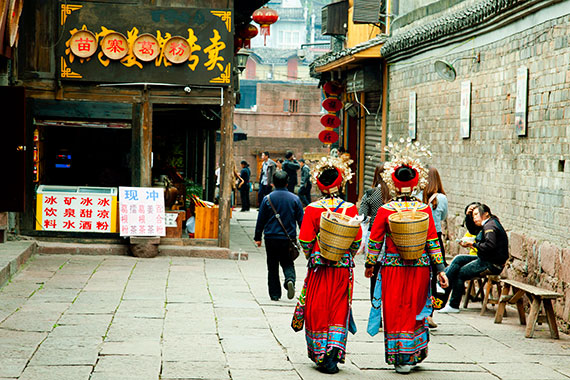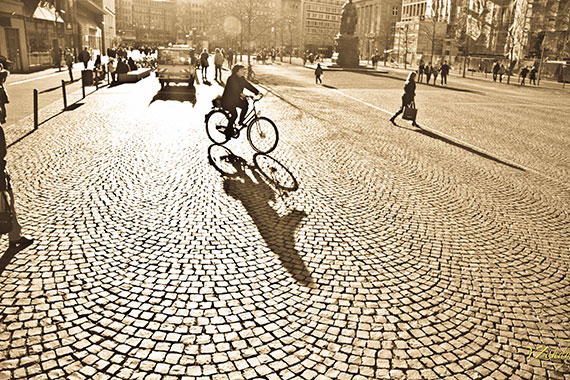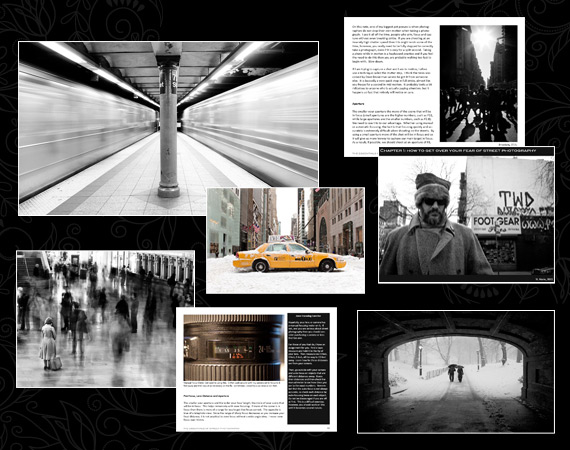*Note: We may not be able to do street photography right now, but it might be a great time to study and strategize for the future. This article is based on concepts from Essentials of Street Photography which is currently 25% off for those who want to study further.
If you are new to street photography, or even if you’re not, remembering settings, nailing the composition, getting idea inspirations, and just getting motivated to get over the fear of doing it can feel daunting. To help make it easier, here’s a cheat sheet full of reminders and setting information to print and take with you, whether you’re traveling or just exploring your hometown.
“Bike Messenger NYC” captured by James Maher.
What To Look For:
- Tell stories – Find details that hint at a larger meaning.
- Emotion – When capturing people, seek out expressive faces, hands, and postures. Also, try to capture images that will invoke a feeling in the viewer.
- Think about how a photograph will age. That storefront window or outfit may seem standard now, but could become much more interesting in 20 years.
- Make photo essays about areas or ideas that you know well.
- Capture unique people. Everyone you see is unique in some way. Figure out why and try to capture that.
- Don’t only photograph people. Capture interesting scenes that say something.
- Street portraiture. Find an interesting background and then stop an interesting person for a portrait in front of it.
Design and Composition:
- Quality and Direction of Light – Seek out interesting and dynamic light. Is the main light source in front of you, behind you, above you?
- Colors – Seek out scenes with interesting colors that complement each other.
- Lines – Are your lines straight? Diagonal Lines can add energy and can lead a viewers eyes into a scene. How will the eyes move around through the scene.
- Corners – What is in each corner of the image? Corners play a large part in creating balance.
- Create relationships – between two or more people or things.
- Balance – Does your photo feel balanced? Is that necessary?

Photo captured by PictureSocial member Chua Chwee Lye.
React:
- Notice people from further away. This will give you more time to get in position and create a good composition.
- Go someplace crowded. If you are especially nervous, crowded areas are the easiest places to try street photography.
- Choose a spot and wait for people to come to you. Choose an interesting background or area ahead of time and wait for people to enter it.
- Use exposure compensation. It’s the fastest way to brighten or darken a scene.
- Don’t walk too fast. It is nearly impossible to observe, walk fast, and capture things all at the same time.
- Patience. Waiting an extra couple of minutes can be the difference between a mediocre image and a once in a lifetime photograph.
- Smile! If someone notices you taking their picture, smile at them. You will be surprised how often they will smile back.

Photo captured by PictureSocial member Yasser Zohdy
Settings
To achieve maximum sharpness:
- Shutter Speed
-Scenes without moving people or objects: 1/focal length (i.e. with a 50mm lens, at minimum, you would want to be at least at 1/50th of a second.)
Scenes with moving people or objects: 1/320th ideal (1/160th minimum). - Aperture
-Use a small aperture (large number) for a larger range of sharpness (large depth of field).
-Using F16 will give you significantly more depth of field than F5.6. - High ISO
-Using a higher ISO (800/1600/3200 depending on lighting conditions) can allow you to use a higher f/stop. - Use a Wide-Angle or Normal Lens (28, 35 or 50mm)
-The wider the focal length the greater the depth of field. - Zone Focus (pre-focusing / hyperfocal distance)
-Turn your camera to manual focusing, set the distance to 10 feet away (or the distance you prefer) with a small aperture, and capture people when they are that distance from your camera. Takes practice to do well.
There are a few other considerations you may want to keep in mind such as setting your camera on shutter priority mode. Manual is good for consistent lighting situations, but is tough to alter constantly in changing light environments. Also, remember that blur isn’t necessarily bad. Photograph moving people at slower shutter speeds – 1/40th to 1/60th – to create a slight blur. It can look fantastic, especially in black and white.
For Further Training, Deal Ending Soon:
NY Street photographer James Maher recently finished a 2nd edition of his popular Essentials of Street Photography eBook. And then was promptly locked down due to the Coronavirus and has been unable to continue with his workshops, tours, events, and portraits business. He is still selling eBooks though, and is currently offering his eBook at 25% off if you want to check it out.
We may not be able to do street photography right now, but it might be a great time to study and strategize for the future. It’s an 180 page eBook covering everything about the genre even down to specific post processing techniques that can bring the best out of street scenes (& includes a bonus eBook of interviews).
Deal found here: Essentials of Street Photography at 25% Off
Go to full article: Street Photography Cheat Sheet
What are your thoughts on this article? Join the discussion on Facebook
PictureCorrect subscribers can also learn more today with our #1 bestseller: The Photography Tutorial eBook
The post Street Photography Cheat Sheet appeared first on PictureCorrect.
from PictureCorrect https://ift.tt/2HhiENz
via IFTTT







0 kommenttia:
Lähetä kommentti